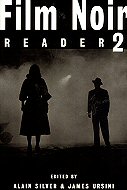|
Film Noir Reader 2
|
|
Edited by Alain Silver & James Ursini
|

|

In the wake of the remarkable success of Film Noir Reader, this new collection further explores a genre of limitless fascination – and one that continues to inspire and galvanize the latest generation of the film-makers.
Again heavily illustrated, with close to 150 stills, Film Noir Reader 2 is organized much like the earlier volume. It begins with "More Seminal Essays", including a New York Times attack on crime pictures, written more than half a century ago, before the French had even given the genre its name: a look at its early development by the noted French director Claude Chabrol; and an analysis, by the American critic Stephen Farber, of how film noir reflects the violence and 'Bitch Goddess" values of contemporary society.
Part Two, "Case Studies", covers specific films, with Robert G. Porfirio comparing the 1946 and 1951 versions of The Postman Always Rings Twice, editor Alain Silver exploring "Hitchcock's Noir Landscape", Grant Tracey's reading of "Samuel Fuller's Tabloid Cinema," and Francis M Nevins tracing the transformation of Cornell Woolrich's fiction into such movie classics as Rear Window and Phantom Lady
"The Evolution of Noir," the book's final section, focuses on the Neo-Noir of our own time: "Son of Noir" (Richard Jameson), and such timely subjects as "Noir Science," (editor James Ursini) and "Girl Power: Female Centered Neo-Noir" (William Covey). It also considers British film noir (Tony Williams) and the cross-cultural movement of "Abstract Expressionism and Film Noir" (Kent Minturn).
In all, Film Noir 2 enriches our understanding of the nature, the power, and the resonance of the genre while it also increases our appreciation of the movies that remain all-time favorites decades after they were first released. They are, indeed, unforgettable, and this book's signal achievement is to explain why.
|
|
